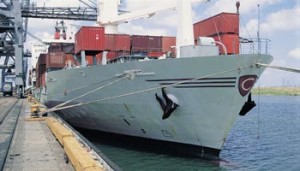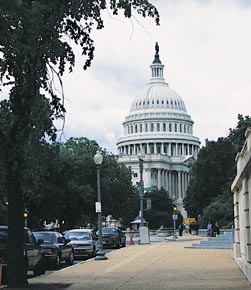By John Johnson

Photo by John Johnson.
Coalition Launches Full-Scale Offensive to Protect Millions of Jobs Worldwide
An all-out offensive was launched on two fronts in recent months by a coalition of textile and apparel industry organizations facing an impending crisis resulting from the worldwide expiration of import quotas on textile and clothing products on Jan. 1, 2005.
U.S. cotton producers, through the National Cotton Council (NCC), are active combatants in the fight to preserve the domestic market for their cotton, more than 6 million bales annually, rather than depend entirely on export markets. Also at stake are 30 million jobs around the world, including almost 700,000 in the United States, that could disappear due to unrestrained textile and apparel imports from China.
Job losses in developing countries would be catastrophic if, as some predict, China captures 75 percent of the U.S. market share and 50 percent of world market share when the quotas expire. Many of the developing countries’ economies have no other jobs to which they can transfer dislocated workers.
Since September, coalition forces comprised of almost 100 industry organizations from the United States and more than 50 other countries have taken their fight before the U.S. government and the World Trade Organization (WTO). Meanwhile, China and its allies have launched their own counter offensive.
 “Instead of viewing China as a friend on textile and clothing issues, the developing world now sees China as a predator stalking them like prey.”GAFTT Statement
“Instead of viewing China as a friend on textile and clothing issues, the developing world now sees China as a predator stalking them like prey.”GAFTT StatementThe National Council of Textile Organizations (NCTO) and five other U.S. textile, apparel and fiber producing trade organizations, including the National Cotton Council, filed the first of several threat-based China textile safeguard petitions on Oct. 8. The petitions were filed with the Committee for the Implementation of Textile Agreements (CITA), a five-member interagency group comprised of representatives from the U.S. Departments of Commerce, State, Labor, and Treasury as well as the Office of the U.S. Trade Representative.
The first petition covered categories 347 and 348 (cotton trousers including denim jeans). Subsequently, the Global Alliance for Fair Textile Trade (GAFTT), a coalition of 96 textile and clothing manufacturing trade associations from 54 countries, issued a statement on Oct. 12 urging the U.S. government to approve the safeguard petition filings.
“If approved, these safeguard petitions will prevent China from taking more than $37 billion in textile and apparel exports in these items which are currently being supplied by dozens of other countries,” GAFTT said. “If the U.S. does not act, China will use currency manipulation and other unfair trade practices to quickly dominate these markets.” The GAFTT claims are well-founded based on recent trade statistics. China’s share of clothing categories released from import quotas in January 2002 increased from 9 percent at that time to 72 percent as of March 2004.

Innovative, value-added denim styles have attracted new customers for PCCA’s Textile Division. Photo by Lynette Cockerell
Before October ended, CITA announced it had agreed to review the petitions for categories 347 and 348. At that point, a 30-day public comment period began followed by a 60-day window during which CITA can make a decision at any time. If the process takes the maximum time period, a final decision will be released during the last week of January 2005, according to NCTO.
If CITA approves the safeguard petition, a consultation period between the United States and China begins, and if no alternative agreement is reached between the parties, the United States can limit imports of Chinese products in the safeguard categories to 7.5 percent growth, NCTO said.
“We are extremely pleased that CITA has accepted for consideration our cotton trousers petition based on the threat of market disruption,” NCTO Chairman Allen Gant said on Oct. 29. “This is definitely a good first step,” he added. “Hopefully, after the 30-day public comment period, the government will then move swiftly to actually approve our petition and impose restraints on Chinese imports in this category. Our industry is looking for our government to approve these petitions and prevent China from taking over virtually the entire U.S. textile and apparel market at the expense of U.S. jobs.” In a letter to CITA Chairman James Leonard, PCCA officials expressed their support for the China safeguard petitions.
“They basically took the market by dropping their prices until they got the business,” wrote PCCA President and CEO Wally Darneille, Vice President of Operations Darryl Lindsey, and former President Van May. “According to the most recent data we have seen, this was an average price reduction of 53 percent,” the PCCA officials added. “This must be exactly the kind of threat our negotiators foresaw when they placed the special safeguards in the WTO accession agreement. As you are well aware, the Chinese agreed to these safeguards and should, therefore, have little redress against them now.”

Wally Darneille
The PCCA officials further stated, “They (China) will likely object and ignore their prior agreement to these terms just as they have ignored the pleas of the international community to float their currency as most of the world’s trading partners do. Their callous disregard for the agreements they make, their predatory pricing history, and their apparent current price quotes below cost all clearly indicate that the threat of disruption to our market is real and imminent.”
On another front, nearly 30 governments on Oct. 1 demanded the WTO’s Council on Trade in Goods undertake an urgent review of the impact that will occur when the textile and apparel quotas are eliminated and to propose solutions to prevent the “almost certain crisis” that will result. The action was hailed by GAFTT in a statement released the same day.
“Today was an historic day for millions of textile and apparel workers around the world whose livelihoods are threatened by countries that use unfair trade practices in order to monopolize world trade in textiles and apparel,” the GAFTT statement read. “While GAFTT is pleased that the WTO has agreed to address the concerns of member countries on the quota expiration issue, there must also be effective action to prevent a few countries from overwhelming the marketplace while the WTO reviews a comprehensive solution to the textile crisis. GAFTT urges that major importing countries recognize the need to employ the special textile safeguard in recognition of the concerns expressed by so many countries today.”
Meanwhile, China and its allies immediately launched counter attacks at the WTO and in Washington, but their initial attempts were unsuccessful. At the Council on Trade in Goods (CTG) meeting on Nov. 25, China, supported by India and Pakistan, again failed to squash discussion on the impact of the quota phase-out, according to a report from NCTO. China’s attempt to end review of the issue was opposed by a large number of developing countries.
China had argued that discussions on the proposal had not achieved “consensus” and, therefore, should be dropped or downgraded to a subcommittee of the World Trade Organization,” NCTO reported. The United States and European Union supported the developing countries’ position. A GAFTT news release also expressed outrage at China’s attempts to stop discussions.
“By its strident opposition to any discussion in the CTG, China unambiguously demonstrated its intention to use its manipulative and unfair trade practices to wrest an additional $100 billion in global textile and apparel trade from other countries,” GAFTT stated. “Instead of viewing China as a friend on textile and clothing issues, the developing world now sees China as a predator stalking them like prey.”
NCTO explained the failure of the Chinese attempts means that the quota impact will continue as a regular issue on the CTG agenda. The organization further reported both Mauritius and Turkey have submitted proposals for the Council to look at solutions to the predicted disruption of world trade. In addition, the failure of China’s initial counter attacks signals that developing countries are coalescing into a potentially powerful bloc that is willing to stand up to the Asian country on textile and apparel issues.
Back in Washington, other China allies began retaliating against the textile safeguard petitions filed by NCTO and its partners. In separate news releases, the U.S. Association of Importers of Textiles and Apparel (USITA), the National Retail Federation and the American Apparel and Footwear Association called the petitions “baseless, misguided, bogus, frivolous and outrageous.” A few weeks later, USITA filed suit with the Court of International Trade to block the U.S. government from proceeding with its review of the safeguard petitions.
The USITA suit, however, is not expected to prevail. According to legal experts contacted by NCTO, appeals to the Court of International Trade in cases of administrative procedure regarding trade agreements are rarely affirmed, and the administering government generally is given wide latitude over how it administers trade agreements.
As Jan. 1, 2005, approached, parties on both sides of the quota phase-out issue anxiously awaited a ruling on the safeguard petitions filed with CITA and to find out what, if any, action would be taken by the WTO. Time will tell if the attempts to halt the anticipated China juggernaut were enough or if they were too little, too late.
In the meantime, efforts to transform the image of PCCA’s Textile Division and reduce operating costs ahead of the quota phase-out to ensure competitiveness appear to be succeeding at this time. The program began more than two years ago via development of value-added denim styles that have attracted several new customers and increased sales volume. More important, the value-added fabrics command premium prices and provide better net margins.
Likewise, Textile Division personnel have completed a number of projects to reduce maintenance expense and increase production capacity. The net result is more than $12 million in total efficiency gains and cost reduction.
“Based on information we have received, PCCA’s Textile Division is enjoying much better business at this time than many of its competitors,” PCCA President and CEO Wally Darneille told the cooperative’s delegate body representatives in November. “This is a good position to be in as the textile and apparel markets enter a new era in 2005,” he added.
“Nevertheless, our Textile Division personnel will continue to develop innovative denim styles and look for other ways to reduce production costs.” Staff also will continue to concentrate on broadening the division’s customer base.
“It is extremely encouraging that, today, we have approximately 50 denim customers, whereas less than 10 years ago we had only one,” Darneille said. “Most jeans producers will follow a ‘balanced sourcing’ model, wherein at least some percentage of their jeans will be produced in this hemisphere, and our goal at American Cotton Growers (ACG) is to do business with as many of those companies as possible. This will help offset the elimination of quotas and position ACG for future growth,” Darneille concluded.


